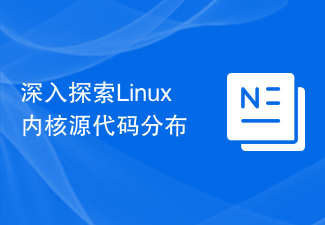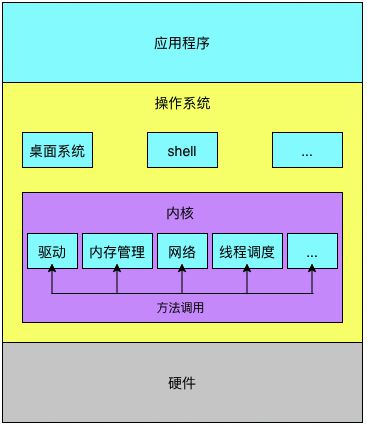 System Tutorial
System Tutorial LINUX
LINUX Analysis and application of Linux kernel 2.1 single kernel and microkernel application system
Analysis and application of Linux kernel 2.1 single kernel and microkernel application systemTable of contents
1. Two forms of application systems 1.1 Application system without operating system
For simple SOC applications, such as most simple-function microcontroller applications, there is no need to use an operating system in the system. At this time, the application directly calls the corresponding driver to operate the underlying hardware, as shown in the figure:
With these structures, the application software directly calls the device driver to operate the hardware. The advantages are: simple, direct and efficient. Suitable for small and simple systems. For complex systems, application systems that need to share hardware resources in different functions, this method is obviously not suitable.
1.2. Application system with operating system
For complex application systems, in application scenarios where hardware and other resources need to be shared between functional modules, an operating system needs to be added to the application system. For this purpose, the application system is as shown on the right:
As shown in the figure, with the operating system Hongqi Linux official website, applications can use the unified socket of the operating system API regardless of specific hardware details, which is conducive to large-scale standardized development and improves development efficiency.
The driver also uses the standard device socket provided by the operating system downwards and operates different hardware upwards. This shields the operating system layer from hardware details. The operating system thus appears more stable and efficient.
2. Linux kernel 2.1 single kernel and microkernel
Currently, the operating system has two typical kernel implementation modes:
Linux is a single-kernel linux learning that runs on a separate address space. However, Linux has absorbed the refinement of the microkernel and has the modular design, preemptive kernel, support for kernel threads, and the ability to dynamically load kernel modules that the microkernel has. At the same time, Linux also prevents the design flaws of microkernelsEmbedded Linux Advanced Driver Tutorial. Linux allows all modules to run in the kernel state and call functions directly without using message passing like microkernels.
2.2Linux kernel composition
As shown in the figure, the Linux kernel mainly consists of five parts:
2.3 Process Scheduling
Process scheduling is at the center of the system, and other parts of the system depend on it. Linux processes have a total of six states, and the process can switch between these states throughout its life cycle.
2.4 Video memory management
The main function of video memory management is to control the safe shared main video memory domain of multiple processes. Each Linux process on a 32-bit processor enjoys 4G space. Usually 0-3G belongs to user space and 3G-4G belongs to kernel space. As shown on the right

2.5 Virtual File System
The Linux virtual file system hides the specific details of various types of hardware and provides a unified socket for all devices. It is a concrete representation of each specific file system.
As shown in the figure, the virtual file system provides a unified calling socket for the underlying application program, which is responsible for calling the member functions in the file_operations structure implemented in the specific underlying file system or device driver.
2.6 Network socket
The network socket provides access to various network standards and support for various network hardware. Linux network sockets are divided into
2.7 Inter-process communication

Inter-process communication is responsible for communication between processes, including semaphores, shared memory, message queues, pipes, UNIX domain sockets, etc.
3. Kernel space and user space
Modern CPUs will internally distinguish different working modes to distinguish operations of different levels and permissions.
For example, ARM’s 8 working modes:
In the ARM environment, the Linux system fully utilizes the hardware characteristics of the CPU to implement two-level operating modes, user (usr) mode and management mode (svc). Correspondingly, there are two types of spaces in the Linux system:
3.1 Supplement: About soft interrupt
qquadHere is a chart of ARM’s abnormal working mode
During normal execution, ARM is in user mode. When the CPU executes the swi instruction, it will manually enter the system mode (SVCmode) and jump to the exception vector table. Jump to the corresponding function through the vector table to respond to swi.
The SVC mode here is the abbreviation of SupervisorCall, which in English is supervisor call.
4. Linux device driver 4.1 Device classification in Linux system
Linux system divides peripheral hardware into three major categories:
4.2linux driver related system
As shown in the figure, character devices and block devices are mapped to files and directories in the Linux file system.
Applications can access network devices through socketsEmbedded Linux Advanced Driver Tutorial, and use two methods to access character devices and block devices:
The above is the detailed content of Analysis and application of Linux kernel 2.1 single kernel and microkernel application system. For more information, please follow other related articles on the PHP Chinese website!
 探秘Linux内核功能:五大部分的详细介绍Mar 21, 2024 am 09:57 AM
探秘Linux内核功能:五大部分的详细介绍Mar 21, 2024 am 09:57 AMLinux内核作为操作系统的核心部分,承担着管理硬件资源、提供系统调用等重要功能。本文将深入探讨Linux内核的五大部分,包括进程管理、文件系统、网络通信、设备驱动和内存管理,并提供详细的介绍和代码示例。一、进程管理进程的创建在Linux内核中,进程的创建通过fork()系统调用来实现。下面是一个简单的示例代码:#include
 非MMU的支持是由Linux内核的uClinux移植提供的吗?Jan 26, 2024 pm 05:18 PM
非MMU的支持是由Linux内核的uClinux移植提供的吗?Jan 26, 2024 pm 05:18 PM篇幅长,技术内容多,点击关注不走散。序言:了解Linux内核一个计算机系统是一个硬件和软件的共生体,它们相互依赖,不可分割。计算机的硬件linux内核移植步骤,富含外围设备、处理器、内存、硬盘和其他的电子设备组成计算机的缸体。并且没有软件来操作和控制它,自身是不能工作的。完成这个控制工作的软件就称为操作系统,在Linux的术语中被称为“内核”,也可以称为“核心”。Linux内核的主要模块(或组件)分以下几个部份:储存管理、CPU和进程管理、文件系统、设备管理和驱动、网络通讯linux论坛,以及系
 实战 | RISC-V Linux入口地址2M预留内存优化Aug 01, 2023 pm 03:37 PM
实战 | RISC-V Linux入口地址2M预留内存优化Aug 01, 2023 pm 03:37 PM上篇分析了RISC-V Linux启动的页表创建,提到RISC-V Linux入口地址必须2M对齐,今天讲讲如何解决2M对齐的问题,或者说如何优化部分内存。
 Linux内核TCP协议栈优化的秘密技巧揭示Jan 28, 2024 am 09:39 AM
Linux内核TCP协议栈优化的秘密技巧揭示Jan 28, 2024 am 09:39 AM尊敬的读者们,您好!在此,我有幸与您分享我作为资深网络工程师,以其专业的技术在Linux内核TCP协议栈的研发及优化工作中所积累下的宝贵经验与技巧。相信通过此文,我们能互相学习、探讨,为对该领域有着浓厚兴趣或正在进行相关工作的你们带来实际且有益的参考资料。1.TCP连接建立TCP连接建立乃是TCP协议栈关键事务,然而面临诸多连接问题并不少见。经过深思熟虑及详细调试,我挖掘出一些普遍存在且实用的问题及其解决方案,包括防范SYN洪泛攻击(可透过调整系统参数)及应对网络拥塞(亦即运用TCPFastOp
 探讨安卓系统与Linux内核之间的关系Mar 14, 2024 pm 12:48 PM
探讨安卓系统与Linux内核之间的关系Mar 14, 2024 pm 12:48 PM安卓系统与Linux内核是息息相关的两个实体,它们之间的关系紧密而又复杂。在安卓系统中,Linux内核充当着重要的角色,为安卓系统提供了底层的硬件驱动和系统调用支持。本文将探讨安卓系统与Linux内核之间的关系,以及它们是如何交互、协同工作的,同时提供一些具体的代码示例。安卓系统是基于Linux内核开发的移动操作系统,主要用于智能手机、平板电脑等移动设备。L
 深入探索Linux内核源代码分布Mar 15, 2024 am 10:21 AM
深入探索Linux内核源代码分布Mar 15, 2024 am 10:21 AM这是一个深度探索Linux内核源代码分布的关于1500字的文章。因为篇幅有限,我们将重点介绍Linux内核源代码的组织结构,并提供一些具体的代码示例,以帮助读者更好地理解。Linux内核是一个开源的操作系统内核,其源代码托管在GitHub上。整个Linux内核源代码分布非常庞大,包含了几十万行代码,涉及到多个不同的子系统和模块。要深入了解Linux内核源代码
 Linux内核:揭秘计算机操作系统的隐形大BOSSMar 24, 2024 am 09:10 AM
Linux内核:揭秘计算机操作系统的隐形大BOSSMar 24, 2024 am 09:10 AM论述了Linux内核在计算机操作系统中发挥重要作用的观点linux内核设计和实现,通过深入解析Linux内核设计及实际应用,揭示了它在该领域的显著地位和影响力量。1.优化的内存管理通过采用虚拟内存管理技术,Linux内核能高效率地完成内存分配与回收。在置换页面算法帮助下linux内核设计和实现,精确处理物理内存至虚拟内存之间的映射关系。依据应用程序具体需求,实现可动调整,从而提升了整个系统性能表现。2.强大的进程管理内核借助其卓越的多任务处理技术,使多个进程能够和谐共处于单一系统中。精心制定的进
 你真的会调试 Linux 内核故障吗,看完这一篇后你会茅塞顿开的!Aug 03, 2023 pm 04:50 PM
你真的会调试 Linux 内核故障吗,看完这一篇后你会茅塞顿开的!Aug 03, 2023 pm 04:50 PMLinux内核是操作系统的核心,它控制对系统资源(例如:CPU、I/O设备、物理内存和文件系统)的访问。在引导过程中以及系统运行时,内核会将各种消息写入内核环形缓冲区。这些消息包括有关系统操作的各种信息。


Hot AI Tools

Undresser.AI Undress
AI-powered app for creating realistic nude photos

AI Clothes Remover
Online AI tool for removing clothes from photos.

Undress AI Tool
Undress images for free

Clothoff.io
AI clothes remover

AI Hentai Generator
Generate AI Hentai for free.

Hot Article

Hot Tools

Atom editor mac version download
The most popular open source editor

MantisBT
Mantis is an easy-to-deploy web-based defect tracking tool designed to aid in product defect tracking. It requires PHP, MySQL and a web server. Check out our demo and hosting services.

Dreamweaver Mac version
Visual web development tools

PhpStorm Mac version
The latest (2018.2.1) professional PHP integrated development tool

Safe Exam Browser
Safe Exam Browser is a secure browser environment for taking online exams securely. This software turns any computer into a secure workstation. It controls access to any utility and prevents students from using unauthorized resources.





